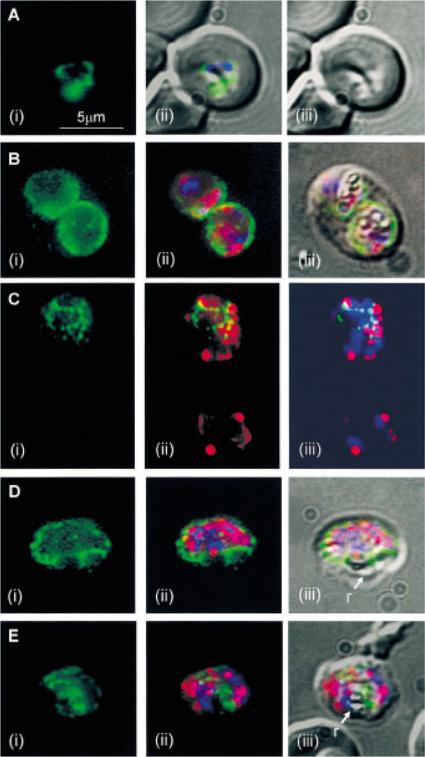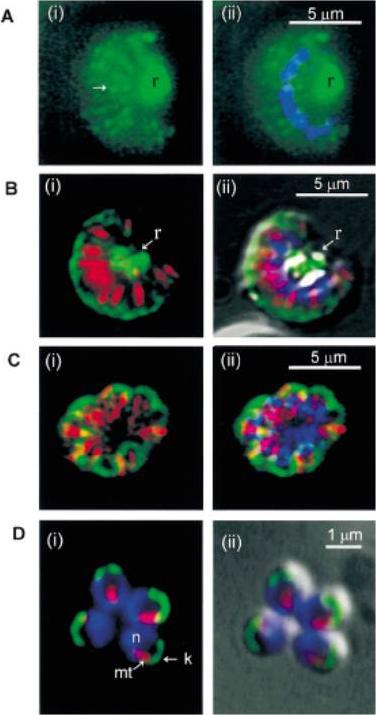PF3D7_0317500 kinesin-5 (EG5)
Disruptability [+]
| Species | Disruptability | Reference | Submitter | |
|---|---|---|---|---|
| P. falciparum 3D7 |
Possible |
USF piggyBac screen (Insert. mut.) | USF PiggyBac Screen | |
| P. berghei ANKA |
Possible |
RMgm-4874 | Imported from RMgmDB | |
| P. berghei ANKA |
Possible |
RMgm-5014 | Imported from RMgmDB | |
Mutant phenotypes [+]
| Species | Stage | Phenotype | Reference | Submitter |
|---|---|---|---|---|
| P. berghei ANKA | Asexual |
No difference |
RMgm-4874 | Imported from RMgmDB |
| P. berghei ANKA | Asexual |
No difference |
RMgm-5014 | Imported from RMgmDB |
| P. berghei ANKA | Gametocyte |
No difference |
RMgm-4874 | Imported from RMgmDB |
| P. berghei ANKA | Gametocyte |
No difference |
RMgm-5014 | Imported from RMgmDB |
| P. berghei ANKA | Ookinete |
No difference |
RMgm-4874 | Imported from RMgmDB |
| P. berghei ANKA | Ookinete |
No difference |
RMgm-5014 | Imported from RMgmDB |
| P. berghei ANKA | Oocyst |
Difference from wild-type |
RMgm-4874
There was no significant difference in the number of kinesin-5 and wild type WT-GFP oocysts, and the size of the oocysts was similar for both parasites. However, we observed a 40 to 50% decrease in the number of sporozoites in each oocyst at days 14 and 21 post-infection in kinesin-5 parasites compared to WT-GFP parasites. |
Imported from RMgmDB |
| P. berghei ANKA | Oocyst |
No difference |
RMgm-5014 | Imported from RMgmDB |
| P. berghei ANKA | Sporozoite |
Difference from wild-type |
RMgm-4874
A significant decrease in the number of kinesin-5 sporozoites in salivary glands was also observed, but the shape, size, and motility of these sporozoites were indistinguishable from WT-GFP parasites. Normal infectivity of sporozoites. |
Imported from RMgmDB |
| P. berghei ANKA | Sporozoite |
Difference from wild-type |
RMgm-5014
(Strongly) reduced sporozoite formation. Sporozoites infective to mice (as shown by infection of mice by mosquito bite). Normal prepatent period after mosquito bite infection |
Imported from RMgmDB |
| P. berghei ANKA | Liver |
Difference from wild-type |
RMgm-4874
Normal infectivity of sporozoites as determined by blood stage infection in mice after infection by mosquito bite |
Imported from RMgmDB |
| P. berghei ANKA | Liver |
Difference from wild-type |
RMgm-5014
(Strongly) reduced sporozoite formation. Sporozoites infective to mice (as shown by infection of mice by mosquito bite). Normal prepatent period after mosquito bite infection |
Imported from RMgmDB |
Imaging data (from Malaria Metabolic Pathways)

Fluorescent images of P. falciparum trophozoites (A&B), and schizonts (C–E), labelled with antibodies to kinesin heavy chain (green) and a-tubulin (red), and DAPI nuclear stain (blue). A(i) kinesin labelling appears as two crescents, each associated with one of the two nuclei, distinguished by the DAPI staining overlaid on the image in plate (ii). The rest of the labelling corresponds to the shape of the parasite cell body, apparent as an indentation in the DIC image in plates (ii) and (iii). B(i) shows two trophozoites inside one red blood cell, showing kinesin labelling, around the periphery of one, and concentrated on one side of the other. C(i) shows kinesin labelling as short linear arrays of fluorescent dots in one parasite, and no labelling in a second parasite at the bottom of the plate. D(i) kinesin labelling appears around the periphery of a schizont. E(i) kinesin labelling appears in the cell body of a schizont. In all plates kinesin labelling was not co-incident with a-tubulin or DAPI staining, nor the residual body (r), seen in the overlaid DIC image. Fowler RE, Smith AM, Whitehorn J, Williams IT, Bannister LH, Mitchell GH. Microtubule associated motor proteins of Plasmodium falciparum merozoites. Mol Biochem Parasitol. 2001 117:187-200. Copyright Elsevier
See original on MMP
Fluorescent images of schizonts undergoing merogony (A–C), and four merozoites (D), labelled with antibodies to kinesin heavy chains (green) and a-tubulin (red), which labels the microtubules of f-MASTs, (merozoite assemblage of sub-pellicular mt) and DAPI nuclear stain (blue). A. Kinesin labelling is primarily associated with the residual body (r), but also radiates out in a series of linear arrays of discrete fluorescent points (Arrow) (i). Nuclei are shown by the DAPI staining (ii). B(i), kinesin labelling is seen at the periphery of the schizont, where the merozoite apices lie, and in the residual body (r), which is distinguished by the white glow of the pigment seen in the overlaid DIC image (ii). C(i), kinesin staining is apparent only at the periphery of the schizont where the merozoite apices are located, and is not apparent in the residual body area. D(i), the nuclei (n) are situated at the base of the merozoites, the f-MASTs (mt) run laterally, and the kinesin labelling (k) appears to be located close to the membrane at the apices, as judged by its proximity to the cell surface in the overlaid DIC image (ii).Fowler RE, Smith AM, Whitehorn J, Williams IT, Bannister LH, Mitchell GH. Microtubule associated motor proteins of Plasmodium falciparum merozoites. Mol Biochem Parasitol. 2001 117:187-200.
See original on MMPMore information
| PlasmoDB | PF3D7_0317500 |
| GeneDB | PF3D7_0317500 |
| Malaria Metabolic Pathways | Localisation images Pathways mapped to |
| Previous ID(s) | MAL3P6.13, PFC0770c |
| Orthologs | PBANKA_0807700 , PCHAS_0808000 , PKNH_0824300 , PVP01_0822600 , PVX_095355 , PY17X_0810900 |
| Google Scholar | Search for all mentions of this gene |